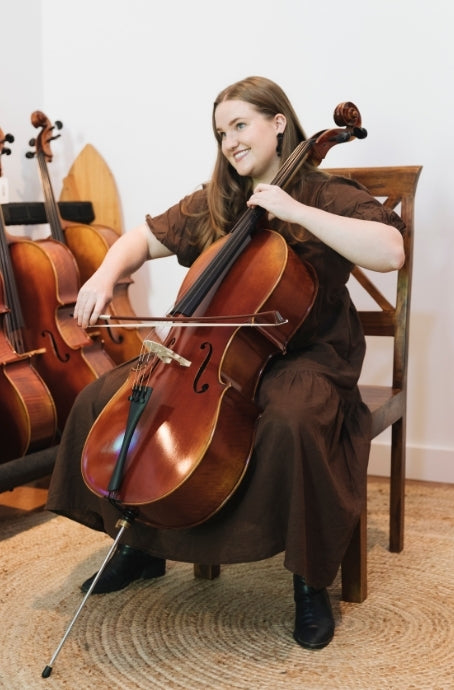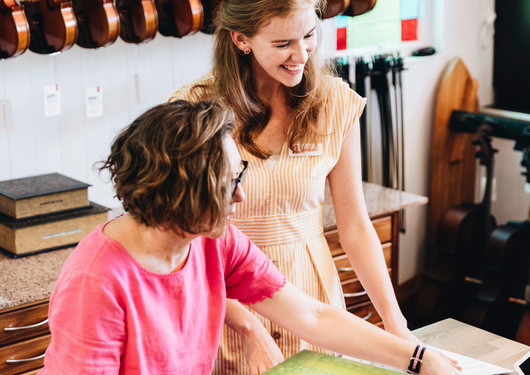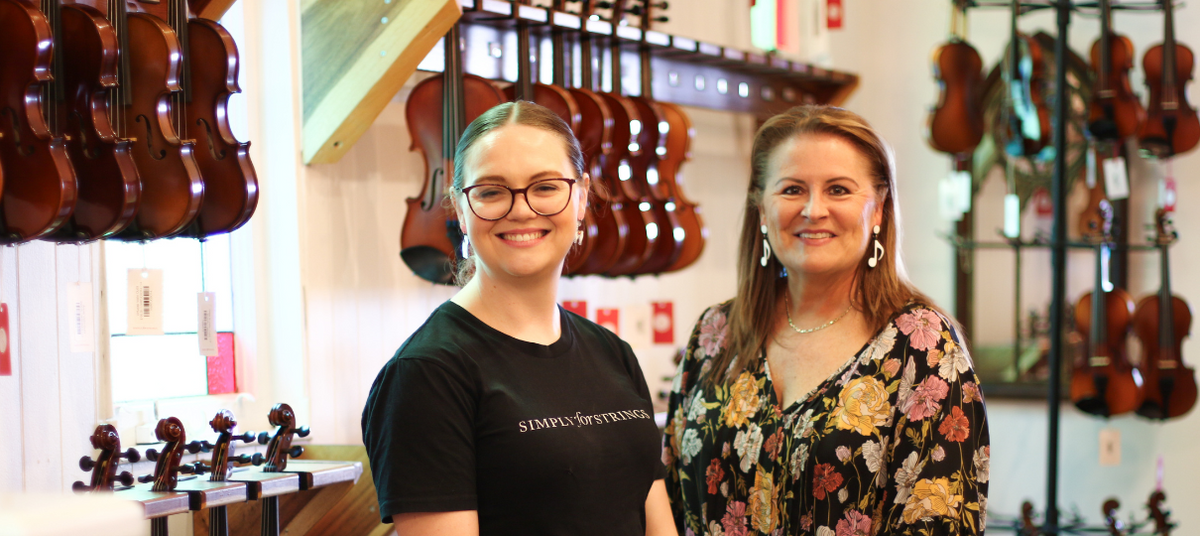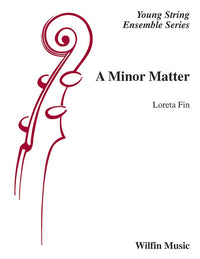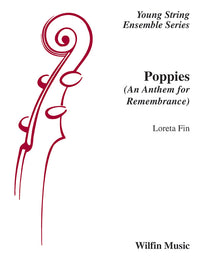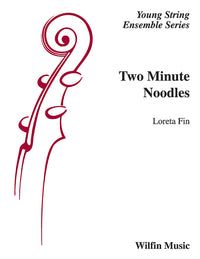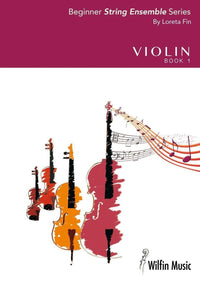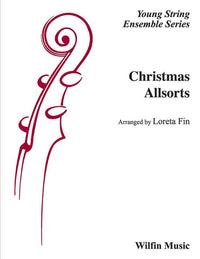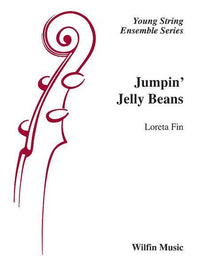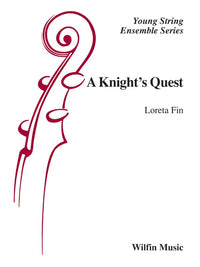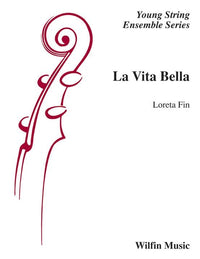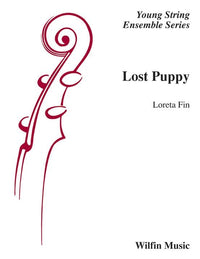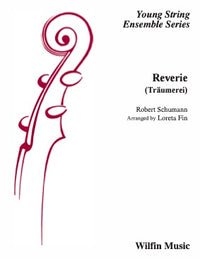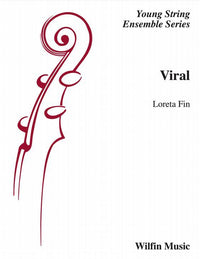Here in Queensland, we are incredibly lucky to be the home of several leading composers and pedagogues. String educators including Stephen Chin, Loreta Fin, Timo Jarvela, Keith Sharp, Anne Svendsen and Neridah Oostenbroek are not only remarkable composers, but they are also regular visitors at our Red Hill store! We’re privileged to support these local composers and teachers, and have had a chat with them over coffee about their compositions, learning methods, and what lies ahead for them in 2024.
In our next interview of our Coffee with Composers series, our Education Manager Jacqui sat down with the incredible Loreta Fin.
Recently appointed a Member of the Order of Australia (AM), Loreta is a remarkable educator, composer, performer, and examiner in our Queensland and Australian string community. Notable career highlights include Director of Strings and Instrumental Music at Sommerville House (1993-2021), Federal Examiner with the Australian Music Examinations Board (AMEB), former National and State President of the Australian Strings Association (AUSTA), Queensland Pops Orchestra’s Principal Violist for over 30 years and much more. Jacqui sat down with Loreta before the school term kicked off to learn more about her compositions, her inspirations, and what is coming in 2024.
Thank you so much for coming in early on a Monday morning. You mentioned you’re off to do some workshops soon - what’s coming up for you in 2024?
I have workshops with Education Queensland coming up soon. They’re not so much professional development in the formal way of ‘talking to the teachers’. It’s where they send their best kids from the region to have an advanced music camp, and so from the podium, I'm conducting and I’m also teaching everyone in the room. I'm not putting it in a way that is authoritative, or saying “You should be doing this”. It’s more me with the ensemble going “Okay, we're going to work on intonation” with the students, so we're going to do this exercise that I do to switch our ears on. Because: “almost, kind-of, sort-of, and nearly” in tune are all out of tune. So, we have to be fussy, and not be happy with “almost, kind-of, sort-of, and nearly”, but how do we get there, how do we do that? What are we actually listening for? So, I do this exercise where I get them all to play a D - which is not an open D string - and then we just move slightly sharp or flat and hear and describe what happens to the sound when it's not in tune, and then they have to find it again. Depending on the age and the experience of the students, we’ll change the difficulty but it’s amazing how quickly they find the pitch again and play in unison. In the next rehearsal, we’ll build on this by establishing unisons in the different sections of the ensemble and how they come together to create chords. By doing things like this, the teachers who are observing are thinking: “Okay, they CAN play in tune, they can hear what a unison is” and so all of this “almost, kind-of, sort-of, and nearly”, shouldn't be happening. I do a lot of work with rhythm as well because I find that kids don’t maintain the beat once they start playing! They’ll count in with you, start playing, and then there’s no more counting or pulse or subdividing. I do a thing where I get the cellos and basses to be a grandfather clock (on the beat), and then add in a wall clock (quavers), and a wristwatch (semiquavers). Then they can choose and seamlessly swap from one to the other! If we’re learning a particular piece which has a new rhythm - say, syncopation - we go from the basis of the grandfather who’s in charge, and from there, all our other rhythms have to fit like a jigsaw puzzle. We keep that going for a good 4 or 5 minutes so that they're just establishing this internal metronome.
You can tell with your beginner books, the Beginning String Ensemble Series that it has a strong emphasis on rhythm and keeping the beat throughout the little pieces.
Well, one piece I have coming out in 2024 is called “Two Minute Noodles” and it really focuses in on keeping pulse and rhythm. It’s in 4-4 time, easy key - nothing hard. But, it uses every basic rhythm you can use in 4-4 time: ti-ti ta ta ta; ta ti-ti ta ta; minims, and all the variations. So they have to count and they can't fall into a pattern - I write a lot of music with this thought in mind. This is quite deliberate to make sure the students are really learning and it makes them think and subdivide. My other repertoire does have some repeated rhythms, where I put myself back in my teacher mind: I think, “It's Term 1, I've got a concert in Week 6; Week 3 is swimming carnival; Week 4 the year 4s go on camp, and then the year 5s go on camp, and then and then… I get my whole group maybe 3 times in total and then I have a concert!” So, I write a lot of stuff where the rhythm is homogeneous so that the violins 1, 2, and 3, are playing the same rhythm but different harmonies, so I only have to teach that 1 rhythm and I can whack that bass line in, and if I need to I’ll whack the piano part in to keep it together but some of the pieces can sit without a piano as well. Particularly in my slower pieces, the piano part is important because it’s the piano that subdivides the beat and gives the more interesting harmony when the students aren’t yet able to play high 3rd fingers and so forth. These kinds of works can be pieced together in one rehearsal, and then whatever I can do between now and then is a bonus. Some pieces, like Two Minute Noodles, are different though!
That’s really interesting! I’ve always been in awe of the scale of your catalogue - obviously, you’ve been doing compositions, workshops, teaching and so on for years and years. Did you come to composing mostly through arranging music for your groups at school?
Yes - I'd say most of us have. Certainly, when I was at the Conservatorium, we had a subject called composition which was more learning four-part harmony and stuff like that. We weren’t really creating original works - it was more like: “write an 8-bar phrase in this particular style with these certain parameters”… it’s not really composition which is fine but it is different. It is how I learned as a child and during my studies. My father once had this kind of competition in our family to write a mass which I still remember, so I did have some ideas already! But yes, when I was working with schools and particular groups with such varied abilities and instrumentation - sometimes with no bass and no violas! I just remember in orchestras myself playing a bad “derangement” (as I call it) of Mozart, and I thought, “I know how Mozart is supposed to sound and we don’t sound like that”. It puts you off, the styles are often wrong and it’s not inspiring. So, when I started writing stuff myself, I knew I wasn’t going to do this - I’m going to write stuff that teaches how to play off the string, call it a crazy name, but teaching the skills that will eventually enable them to play Mozart!
I do have to ask… how do you come up with some of these names?! Two Minute Noodles, Molto Mambo, there’s so many.
For me the name always comes last in the process. My process starts with the question "what am I trying to teach?". I always come from this question. For example, I’m trying to teach a syncopated rhythm; I'm trying to teach every rhythm you can possibly play in 4-4; I'm trying to teach a low first finger; I'm trying to teach extended third; I'm trying to play in a particular key; I’m trying to teach minor tonality; and so forth. It comes from the pedagogical aspect of what am I trying to teach. I go from there to making sure that everybody has a little bit of something to do - but then, I have actually also written pieces where the first violins have majority of the melodic material because - often, let’s face it - normally what happens is that you make your way from 3rd violin, to 2nd violin, to 1st violin from year 3 to year 6. Especially in those schools that don’t have 3 different levels of string ensembles and other orchestras. We have to, as composers, keep that in mind too! You do not want to write some hair-raising thing in nosebleed-territory on the viola, when they have only been playing in first position. Most of my pieces are geared towards that primary school to middle school audience because there are lots of composers out there writing stuff for the more advanced ensembles. There’s so much music for these more advanced kids but there isn't a great deal of music for that lower level and limited experience. Once the piece is pretty much done and I've made sure that everybody gets a little bit of something to do, I’ll go, "What does this piece sound like?". Usually, a name will come fairly easily - I use a lot of alliteration - Tango Time, Fiddler’s Farewell, Koala Kanon, Kalypso Kangaroo, there are many more! The American audiences really like the Australian-themed titles.
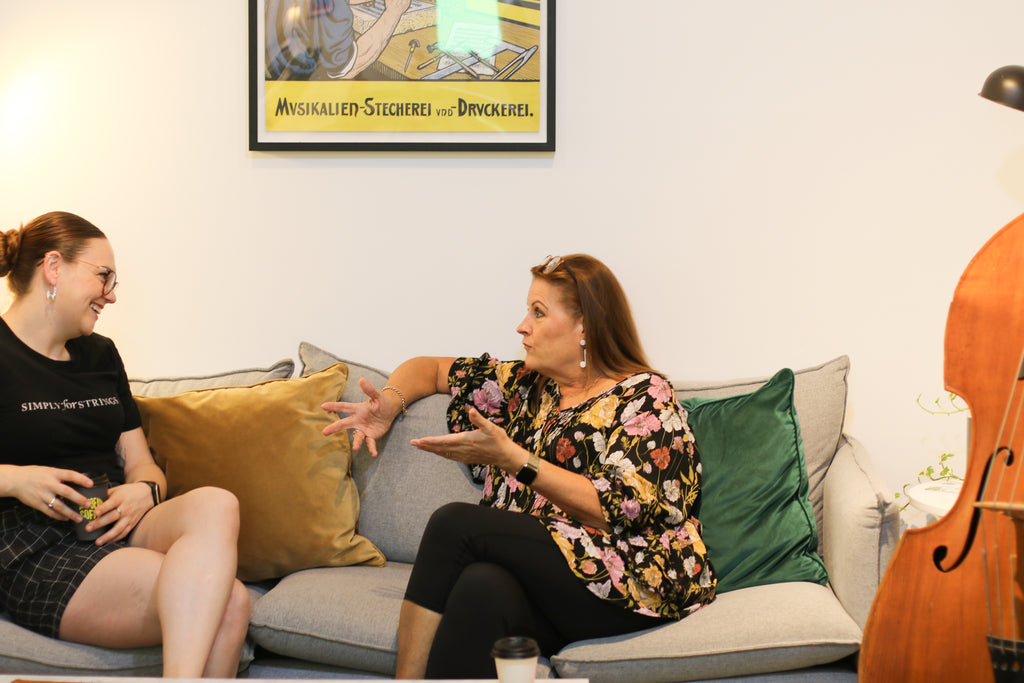
Do you find that you ever hit writer’s block or similar, having a pedagogical focus?
I rarely get writer’s block in the middle of a piece. Once I start, I’m usually okay. Because I’m aiming for four new pieces a year, I already have an idea of what I’m hoping to achieve or what I’m trying to teach. But if I haven’t decided my focus - I just start. Perhaps I hadn’t written much in F Major, or in a compound time signature and such for a while. I try to keep the notes simple, but add in one or two other more complex elements. If I were to get a writer’s block, I would just start writing, with some little parameters in place, and then just go! Maybe even leave it and come back later.
How do you go about choosing music for different ensembles and do you have any advice for teachers choosing repertoire?
With the freelance work that I'm doing now, I never quite know the level of experience or precise playing ability of the students until I get there. I would have, for example, spoken to SHEP staff and then choose 10 pieces, and within the first rehearsal, I can eliminate a few. You’ve got to have that range of level, different styles, different composers - material to keep everyone engaged. I find it’s best to not choose music that is too beyond the kids and don’t go too advanced. Find good quality stuff that is easy to play and enjoyable - but still teaching something. That is really important because that's the purpose of what we're doing. Some of my pieces like Kalypso Kangaroo are basic pieces but the kids can play and learn the notes quickly, so we can work on musical aspects. I think there’s nothing worse - and I remember this myself - than sitting in an ensemble and thinking to myself, "oh, we sound awful and so out of tune!". If the repertoire is overshooting the mark, they’re not going to play it well. My general go-to framework at school was to have 3 pieces a term: one that’s harder and that we may not play for a while, one that we could play next week, and one that sits somewhere in the middle. Once the easier one is ready, you can bring in another one, and you can build your repertoire like that. You always had three pieces ready for a concert - always thinking ahead a little bit, but also being that little bit “prepared for anything”. You never know when someone's going to ring you and ask you to play at an opening night or assembly presentation or whatever … next week!
What about in terms of setting up yourself for those long-term projects, or maybe teachers who are starting at a new school? It can be incredibly daunting, particularly for our regional educators!
Well, my go-to would be the AUSTA Reading Day at the beginning of the year. We introduce all of the new repertoire - Stephen Chin, Keith Sharp, Timo Jarvela, Neridah Oostenbroek, my own works - there are loads of really interesting Australian composers, and I’m a great believer in supporting the local product. We also do a ‘Best Of’ selection of our overseas new releases for each publisher level. I think for too many years we've tended to think that things that come from overseas must be better. Don’t get me wrong, there is some fabulous repertoire, but some of the overseas composers have gone the pop music route - which is fine! You might need some fun pieces for a themed concert or end-of-year - or even just as an occasional fun piece for your group – Stephen Chin and I were renowned for dressing up in crazy outfits to conduct some fun piece in our combined string festivals. But the rest of our program was fairly sound pedagogical stuff. There’s absolutely nothing wrong with having a fun piece, but not your entire repertoire. So, that would be my first piece of advice: go to these reading days - everything you hear or play on these reading days has been vetted and will save you so much time. AUSTA has the ability to get these pieces from Reading Days to other regional branches or interested groups of educators - so reach out to your locals, get a group together and borrow these folders from AUSTA! As string teachers - particularly if in regional or remote areas - we have to network with and support each other, because you can feel really alone. I have so much respect for our colleagues in regional areas.
My second piece of advice would be to join AUSTA, save your pennies and get to AUSTA events - they have some great conferences and workshops. I always say: “There are 3 reasons to go to professional development events like this...
1. To hear what’s being said and have affirmation of what you’re doing
2. To be reminded of tools and tricks that you might have forgotten
3. The ‘light-bulb’ moment - which should happen to everyone no matter their level of teaching experience.”
If you can find one thing that just blows your mind and makes you go “Wow, I've NEVER thought of it that way before”, then you haven’t wasted your money. From a good PD session, that’s what you’ll get. Also, just go and watch people doing stuff, take advantage of PD days, and there’s some financial help or sponsorships available for many of these types of events if you’re really keen.
You’ve mentioned these workshops and events for 2024. Can you tell us a bit more about these?
I’m actually going to the Northern Territory - to Darwin - with SHEP this year! I’m really excited because I’ve never been to Darwin. That's what I love about the SHEP program is that it's an outreach program - we get out there and these kids are just lapping these opportunities up; they just love it. I’m also working with the QSO GEM program, as well as the Ed Qld Creative Generations Program. These programs are simply incredible and the kids are so, so well-behaved! They might be one of only 6 or 7 in their school ensemble and then they get to come into this big ensemble and hear its mighty sound. I still get chills thinking about my first experience in an orchestra. Sydney Youth Orchestra Camp was a massive moment in my music journey, just hearing the brass blasting behind me, it was just awesome.
Oh, absolutely! My first SHEP program was the first time I had ever played in an ensemble with more than 30 people; and I didn’t play in a full orchestra until I was 17!
It’s such an experience - and even though it’s not great for my ears, I don’t like wearing earplugs because I relish the experience of letting the sounds wash over me.
What can we expect composition-wise from you this year?
In terms of compositions, there are four coming out this year! Poppies is influenced by the ANZAC day traditions and ‘The Last Post’; Two Minute Noodles, which focuses on rhythm; A Minor Matter, which introduces half position on all instruments; and an arrangement of Schubert’s ‘Reverie’ from Traumerei for the more advanced groups!
We hope you found our conversation with Loreta as delightful as we did, gaining deeper insight into her remarkable passion for music education and composition. We're excited for the chance to delve into the creative journeys of more local composers in our upcoming interviews. Be sure to stay tuned for the next edition of Coffee with Composers, where we'll continue to uncover the captivating world of music creation with our exceptional local talents.





